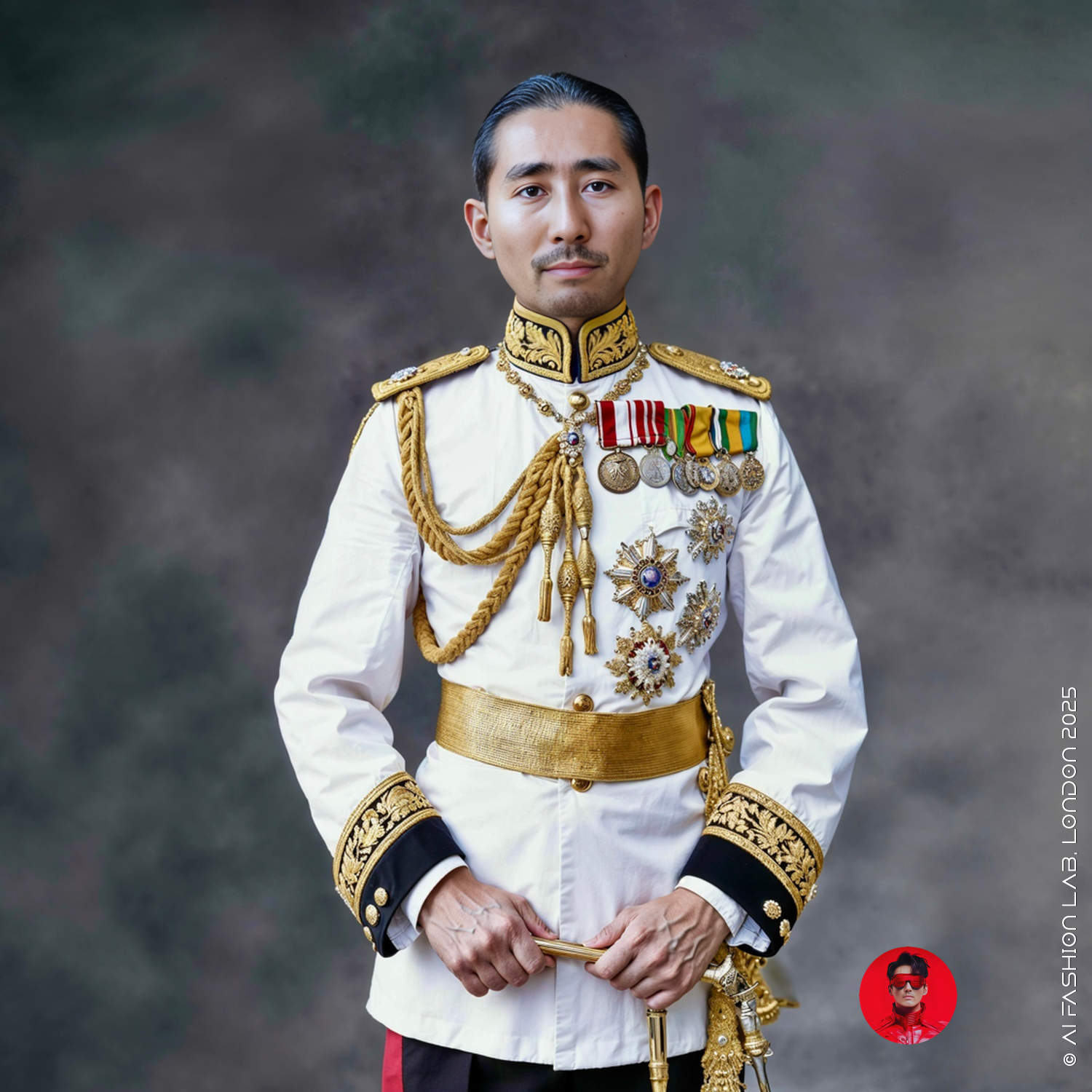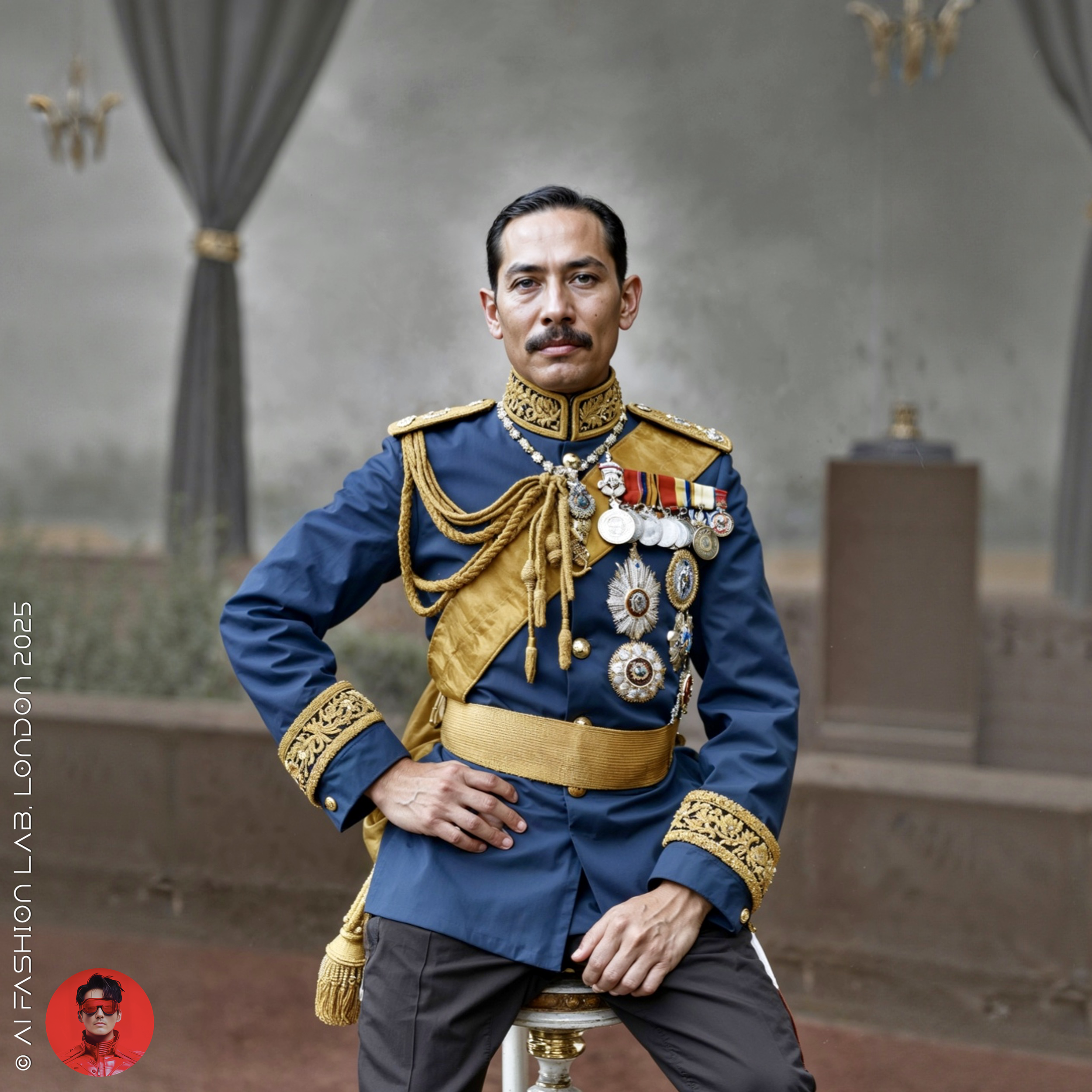The Adoption of Western Dress Uniform in the Thai Court: A Fashion History
The Adoption of Western Dress Uniform in the Thai Court: A Fashion History
The transition from traditional Siamese court attire to Western-style dress uniforms was a gradual yet significant transformation that reflected Siam’s modernisation efforts during the late 19th and early 20th centuries. This shift was closely tied to King Chulalongkorn’s (Rama V) policies of state reform and diplomacy, which sought to align Siam with global standards while preserving its sovereignty amidst colonial pressures.
The introduction of Western military-style uniforms in the Thai court can be traced back to King Mongkut (Rama IV), who first adopted elements of European dress for diplomatic occasions. However, it was during the reign of King Chulalongkorn (1868–1910) that such uniforms became a formalised aspect of royal and government dress. Inspired by European courts, the King and high-ranking officials began wearing tailored military jackets adorned with medals, epaulettes, and aiguillettes, often paired with traditional phanung chongkraben (a draped lower garment) in the early phases of adoption.
By the time of King Vajiravudh (Rama VI, 1910–1925), the Western-style full dress uniform had become the official court attire for military and civil officials, replacing older hybrid styles. The long-standing tradition of wearing chongkraben with a European jacket gradually gave way to Western trousers, particularly for formal state functions and military ceremonies. These uniforms, influenced by British and French military attire, symbolised discipline, hierarchy, and modern governance in Siam.
Even today, the legacy of these dress uniforms remains visible in Thai official and military attire, particularly in royal ceremonies and state functions. The incorporation of European-style uniforms into the Thai court represents not just a shift in fashion but a deeper cultural and political evolution, balancing modernisation with national identity.
A Birthday Celebration with a Historical Twist! 🎉👑
Since today is my birthday, I thought it would be fun to add AI-generated portraits of myself wearing the early 20th-century Siamese dress uniform from the reign of King Rama VI! I wanted to capture the elegance of that era, with the beautifully embroidered military tunic, high collar, and ceremonial sash that defined the formal court attire of the time.
Do these AI portraits look like real historical photographs? 😆 Let me know what you think! Are they regal enough? Or should I add a few more medals for good measure? 😂
Cheers to another year and to celebrating Thailand’s rich sartorial heritage! 🎂🎖️
เครื่องแบบข้าราชการตะวันตกในราชสำนักไทย
การเปลี่ยนแปลงจากเครื่องแต่งกายราชสำนักแบบไทย สู่ เครื่องแบบข้าราชการและเครื่องแบบทหารแบบตะวันตก ถือเป็นจุดเปลี่ยนสำคัญที่สะท้อนถึง การปรับตัวของสยามสู่ความทันสมัย ในช่วงปลายศตวรรษที่ 19 และต้นศตวรรษที่ 20 ซึ่งสอดคล้องกับ นโยบายปฏิรูปของพระบาทสมเด็จพระจุลจอมเกล้าเจ้าอยู่หัว (รัชกาลที่ 5) ที่ต้องการให้สยามสามารถแข่งขันและรักษาเอกราชท่ามกลางกระแสลัทธิล่าอาณานิคมของชาติตะวันตก
ต้นกำเนิดของเครื่องแบบตะวันตกใน ราชสำนักไทย สามารถสืบย้อนไปถึง รัชสมัยพระบาทสมเด็จพระจอมเกล้าเจ้าอยู่หัว (รัชกาลที่ 4) ซึ่งทรงเป็นกษัตริย์พระองค์แรกที่ทรงนำองค์ประกอบของเครื่องแต่งกายยุโรป มาใช้ในโอกาสทางการทูต อย่างไรก็ตาม การนำ เครื่องแบบข้าราชการและเครื่องแบบทหารตะวันตก มาใช้อย่างเป็นทางการเกิดขึ้นอย่างชัดเจนใน รัชสมัยพระบาทสมเด็จพระจุลจอมเกล้าเจ้าอยู่หัว (พ.ศ. 2411–2453) ซึ่งทรงได้รับอิทธิพลจากราชสำนักยุโรป โดยเฉพาะอย่างยิ่ง อังกฤษและฝรั่งเศส
ในช่วงแรกของการปรับตัว พระมหากษัตริย์และข้าราชการชั้นผู้ใหญ่ทรงนิยมสวม เสื้อแจ็กเก็ตทหารตะวันตกที่ประดับเครื่องราชอิสริยาภรณ์และอินทรธนู คู่กับ ผ้านุ่งโจงกระเบน แต่เมื่อเข้าสู่ รัชกาลที่ 6 (พ.ศ. 2453–2468) รูปแบบของ เครื่องแบบเต็มยศ แบบตะวันตกได้รับการปรับใช้เป็น เครื่องแต่งกายทางการของราชสำนักและหน่วยงานราชการ อย่างเต็มรูปแบบ
ในสมัยรัชกาลที่ 6 เครื่องแบบข้าราชการและทหารของไทย ได้รับแรงบันดาลใจจาก กองทัพอังกฤษและฝรั่งเศส ซึ่งกลายเป็นมาตรฐานใหม่สำหรับข้าราชการชั้นผู้ใหญ่ รวมถึงเจ้าพนักงานในพระราชสำนัก การสวมใส่เครื่องแบบตะวันตกในโอกาสสำคัญ เช่น พระราชพิธี รัฐพิธี และงานเลี้ยงทางการทูต กลายเป็นธรรมเนียมปฏิบัติที่แสดงถึง ระเบียบวินัย ลำดับขั้น และอำนาจของรัฐสมัยใหม่
จนถึงปัจจุบัน เครื่องแบบเต็มยศของราชสำนักไทย ยังคงสะท้อนถึง มรดกทางแฟชั่นที่ได้รับอิทธิพลจากยุโรป โดยเฉพาะในการ พระราชพิธีสำคัญและงานรัฐพิธี การนำเครื่องแบบตะวันตกเข้ามาในราชสำนักไทย ไม่ได้เป็นเพียงแค่การเปลี่ยนแปลงด้านแฟชั่น แต่ยังเป็นการผสมผสาน อัตลักษณ์ไทยเข้ากับมาตรฐานสากล เพื่อสะท้อนให้เห็นถึงความเป็น สยามสมัยใหม่
วันเกิดปีนี้ ขอฉลองด้วยชุดเต็มยศโบราณ! 🎉👑
เนื่องจาก วันนี้เป็นวันเกิดของผม ผมเลยอยากเพิ่มสีสันให้กับวันพิเศษนี้ด้วย ภาพที่สร้างจาก AI ซึ่งจำลองให้ผม สวมชุดเต็มยศข้าราชการสยาม ในช่วงต้นศตวรรษที่ 20 สมัยรัชกาลที่ 6! 🎖️✨
ผมอยากลอง ถ่ายทอดความสง่างามของยุคนั้น ผ่าน เสื้อเครื่องแบบข้าราชการปักลายทอง คอสูง และสายสะพายอันเป็นเอกลักษณ์ ซึ่งใช้ใน พระราชพิธีและงานรัฐพิธีของราชสำนัก
ภาพ AI ที่ผมสร้างขึ้นนี้ ดูเหมือนภาพถ่ายโบราณในสมัยนั้นไหมครับ? 😆 หรือว่า ควรเพิ่มเครื่องราชฯ และเหรียญตราอีกสักหน่อยเพื่อความสมจริง? 😂
ขอให้ทุกคนร่วมเฉลิมฉลองประวัติศาสตร์เครื่องแต่งกายไทยกับผมในวันนี้ครับ! 🎂🎖️✨
#aifashionlab #AI #aiartist #aiart #aifashion #aifashiondesign #aifashionstyling #aifashiondesigner #fashion #fashionhistory #historyoffashion #fashionstyling #fashionphotography #digitalfashion #digitalfashiondesign #digitalcostumedesign #digitaldesign #digitalaiart #ThaiFashionHistory #ThaiFashionAI #flux #fluxlora



































